 Last November, we posted that the National Transportation Safety Board (NTSB) had ended its search for the El Faro‘s Voyage Data Recorder (VDR), the so-called “black box,” which might have provided answers to questions about the sinking of the 790-foot long ro/ro-container ship. El Faro was lost in Hurricane Joaquin with the loss of 33 crew in the beginning of October in 2015. The wreckage of the ship was located off Crooked Island in the southeastern Bahamas. Now the NTSB has restarted the search using a “sophisticated autonomous underwater vehicle”, AUV Sentry.
Last November, we posted that the National Transportation Safety Board (NTSB) had ended its search for the El Faro‘s Voyage Data Recorder (VDR), the so-called “black box,” which might have provided answers to questions about the sinking of the 790-foot long ro/ro-container ship. El Faro was lost in Hurricane Joaquin with the loss of 33 crew in the beginning of October in 2015. The wreckage of the ship was located off Crooked Island in the southeastern Bahamas. Now the NTSB has restarted the search using a “sophisticated autonomous underwater vehicle”, AUV Sentry.
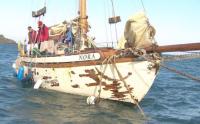 Steve Shapiro’s frequently rescued sailboat Nora, has been sold. In January, we posted about a pair of American sailors who had been rescued nine times in sailing from Norwalk to Cornwell in the UK on a 40′ gaff rigged sloop named Nora. The two sailors, Bob Weise and Steve Shapiro, both 71, had been attempting to sail across the Atlantic from Norway to Maine but had suffered a variety of breakdowns and groundings which resulted in calling for help from rescue teams from Norway, Scotland, Ireland and the UK.
Steve Shapiro’s frequently rescued sailboat Nora, has been sold. In January, we posted about a pair of American sailors who had been rescued nine times in sailing from Norwalk to Cornwell in the UK on a 40′ gaff rigged sloop named Nora. The two sailors, Bob Weise and Steve Shapiro, both 71, had been attempting to sail across the Atlantic from Norway to Maine but had suffered a variety of breakdowns and groundings which resulted in calling for help from rescue teams from Norway, Scotland, Ireland and the UK.
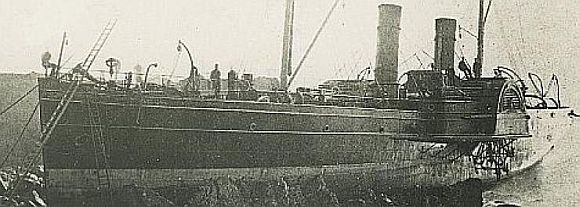 The Confederate blockade runner Agnes E. Fry is believed to have been located off Oak Island, North Carolina. She is one of three blockade runners lost in the area during the Civil War, but the only ship longer than 200 feet. The Agnes E. Fry was a 559-ton iron side-wheel steamer built by Caird & Company at Greenock, on the River Clyde in 19864. The blockade runner was 237 feet long by 25 feet in beam, with a depth of hold of 13 feet. She made two successful runs into Wilmington before being lost on her third attempted voyage, two days after Christmas 1864.
The Confederate blockade runner Agnes E. Fry is believed to have been located off Oak Island, North Carolina. She is one of three blockade runners lost in the area during the Civil War, but the only ship longer than 200 feet. The Agnes E. Fry was a 559-ton iron side-wheel steamer built by Caird & Company at Greenock, on the River Clyde in 19864. The blockade runner was 237 feet long by 25 feet in beam, with a depth of hold of 13 feet. She made two successful runs into Wilmington before being lost on her third attempted voyage, two days after Christmas 1864.
In observance of the anniversary of the sinking of the Titanic on April 15, 1912, here is a repost from 2012, about two hardy souls who survived not only the sinking of the RMS Titanic but also the RMS Britannic when she was sunk by a mine and the RMS Olympic when she collided with the HMS Hawke.
Arthur John Priest was a stoker, or fireman, on the RMS Titanic. His job was to shovel coal into the ship’s boilers. He survived the Titanic’s sinking of 1912. He also was aboard the RMS Olympic, the sistership to the Titanic, when she collided with HMS Hawke in 1911.
Priest was also aboard the Britannic, the third sistership to the Olympic and the Titanic when she hit a mine and sank in 1916. Priest also survived the World War I losses of the Alcantara and Donegal. He once claimed that he was forced to retire from the sea by these disasters because no one wished to sail with him. Priest died at the age of 50 of pneumonia Southampton.

Violet Jessop
More famous and longer lived than Priest was Violet Jessop, a nurse who was coincidentally also onboard the RMS Olympic during the collision with HMS Hawk and during the sinkings of both the Titanic and the Britannic. Ms. Jessop died of heart failure at the age of 84. Characters based on Ms. Jessop have appeared in two movies and a play about the sinking of the Titanic.
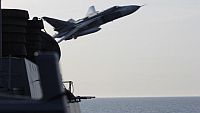 The Russians do not appear to like the US Navy operating ships in the Baltic Sea. On Aprill 11, two unarmed Russian SU24 fighter jets made low attitude passes at the US Navy destroyer USS Donald Cook. Then, on April 12, two Russian KA27 Helix helicopters flew several circles around the Donald Cook, apparently taking photos. Later, two unarmed SU24 jets made approximately a dozen very close, low-level passes of the ship in what the official described as “Simulated Attack Profile.” When the incidents took place the Donald Cook was roughly 70 nautical miles from the Russain port of Kaliningrad in international waters in the Baltic Sea, having sailed from Gdynia, Poland.
The Russians do not appear to like the US Navy operating ships in the Baltic Sea. On Aprill 11, two unarmed Russian SU24 fighter jets made low attitude passes at the US Navy destroyer USS Donald Cook. Then, on April 12, two Russian KA27 Helix helicopters flew several circles around the Donald Cook, apparently taking photos. Later, two unarmed SU24 jets made approximately a dozen very close, low-level passes of the ship in what the official described as “Simulated Attack Profile.” When the incidents took place the Donald Cook was roughly 70 nautical miles from the Russain port of Kaliningrad in international waters in the Baltic Sea, having sailed from Gdynia, Poland.
The US Navy posted videos of the Russian planes buzzing the Cook on Youtube.
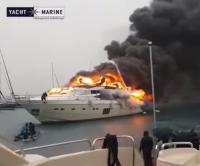 The headlines in the UK Daily Mail and Bloomberg ask the same question — “Why Are All These Superyachts Catching on Fire?” This year has seen a string of fires on “superyachts.” In early January, in the Mediterranean resort town of Marmaris, Turkey, a fire broke out on the 239′ yacht The One before spreading to the 170′ yacht Barbie. Later in January, the 95′ yacht Queen Anna was destroyed by fire at a marina in Fethiye, Turkey. In early March, a fire broke out at the Abu Dhabi Marina Yacht Club, destroying eight yachts, three of which were over 90′ long, including the 101′ yacht Asfar. Also in March the 77′ yacht Positive Energy went up in flames at Charlotte Amalie harbor on St Thomas, in the Virgin Islands.
The headlines in the UK Daily Mail and Bloomberg ask the same question — “Why Are All These Superyachts Catching on Fire?” This year has seen a string of fires on “superyachts.” In early January, in the Mediterranean resort town of Marmaris, Turkey, a fire broke out on the 239′ yacht The One before spreading to the 170′ yacht Barbie. Later in January, the 95′ yacht Queen Anna was destroyed by fire at a marina in Fethiye, Turkey. In early March, a fire broke out at the Abu Dhabi Marina Yacht Club, destroying eight yachts, three of which were over 90′ long, including the 101′ yacht Asfar. Also in March the 77′ yacht Positive Energy went up in flames at Charlotte Amalie harbor on St Thomas, in the Virgin Islands.
 The Navy’s newest destroyer, the $7.5 billion USS Zumwalt, is designed to be stealthy. The ship is intended to be 50 times harder to detect on radar than current destroyers thanks to its angular shape and other design features. This is turning out to be a problem. The ship is now undergoing sea trial and testing off the often foggy coast of Maine. She is apparently very difficult for local boats to spot.
The Navy’s newest destroyer, the $7.5 billion USS Zumwalt, is designed to be stealthy. The ship is intended to be 50 times harder to detect on radar than current destroyers thanks to its angular shape and other design features. This is turning out to be a problem. The ship is now undergoing sea trial and testing off the often foggy coast of Maine. She is apparently very difficult for local boats to spot.
Lawrence Pye, a lobsterman, told The Associated Press that on his radar screen the 610-foot ship looked like a 40- to 50-foot fishing boat. He watched as the behemoth came within a half-mile while returning to shipbuilder Bath Iron Works. “It’s pretty mammoth when it’s that close to you,” Pye said.
So, what is to be done? Gizmodo is reporting that the Navy plans to install removable radar reflectors to avoid wreaking havoc on local mariners.
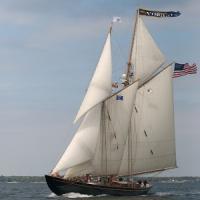 In the Summer of 2014, the schooner Virginia ended her season early. The Virginia Maritime Heritage Foundation which operated the schooner announced that she would be put up for sale. Now, Nauticus, a maritime-themed science center and museum located on the downtown waterfront in Norfolk, Virginia, is planning to buy the schooner with funds from a $1 million state grant. $850,000 will go to purchase the schooner, with the remained used for maintenacne and upkeep.
In the Summer of 2014, the schooner Virginia ended her season early. The Virginia Maritime Heritage Foundation which operated the schooner announced that she would be put up for sale. Now, Nauticus, a maritime-themed science center and museum located on the downtown waterfront in Norfolk, Virginia, is planning to buy the schooner with funds from a $1 million state grant. $850,000 will go to purchase the schooner, with the remained used for maintenacne and upkeep.
The schooner Virginia is a reproduction of the last all sail pilot vessel built for the Virginia Pilot Association. She is 114′ on deck and sets 6,538 square feet of sail. The original ship sailed for the pilots from 1917-1926, training apprentice pilots in seamanship and navigation. The reproduction was built in Norfolk between 2002-2004. The Nauticus Foundation plans to use the schooner as part of Sail Nauticus, a program that gives underprivileged children around Hampton Roads access to the water.
 Captain Robert M. Cusick was born today on April 10, 1923, in Boston, Massachusetts. He was the chief mate and one of only three survivors on the SS Marine Electric when she sank on February 12, 1983. His testimony in the investigation which followed helped lead a major reform of US maritime safety standards.
Captain Robert M. Cusick was born today on April 10, 1923, in Boston, Massachusetts. He was the chief mate and one of only three survivors on the SS Marine Electric when she sank on February 12, 1983. His testimony in the investigation which followed helped lead a major reform of US maritime safety standards.
When the Marine Electic sank, Cusick was throw into the 39 degree F Atlantic waters. He found a swamped lifeboat and hauled himself aboard. As the seas broke over him he found himself singing “rise again, rise again” from Stan Rogers’ song, “The Mary Ellen Carter.” Here is Captain Cusick telling the story from the documentary, “One Warm Line.” Captain Cusick died on Thursday September 12, 2013 at the age of 90.
Stan Rogers performs “The Mary Ellen Carter” in One Warm Line documentary
Thanks to Paul Bryant-Smith for contributing to this post. Continue reading
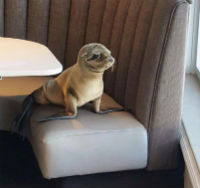 So, a sea lion pup wanders into a seafood restaurant and settles down in a booth ….. It sounds like the beginning of a bad joke, but last February, a malnourished 8-month old sea lion pup appeared in a booth in The Marine Room, an upscale waterfront restaurant in La Jolla, California. The pup had found its way in from the beach through a door left open by a cleaning crew. Chef Bernard Guillas said that the female pup climbed into a booth “almost like she wanted to have dinner.” And perhaps she did, as the pup was seriously malnourished and dehydrated, weighing only 20 pounds (9 kg), less than half the normal size for its age.
So, a sea lion pup wanders into a seafood restaurant and settles down in a booth ….. It sounds like the beginning of a bad joke, but last February, a malnourished 8-month old sea lion pup appeared in a booth in The Marine Room, an upscale waterfront restaurant in La Jolla, California. The pup had found its way in from the beach through a door left open by a cleaning crew. Chef Bernard Guillas said that the female pup climbed into a booth “almost like she wanted to have dinner.” And perhaps she did, as the pup was seriously malnourished and dehydrated, weighing only 20 pounds (9 kg), less than half the normal size for its age.
The sea lion pup, which has been given the nickname Marina, wasn’t served at the restaurant but was instead taken to SeaWorld’s Animal Rescue Center. Since then Marina has been nursed back to health. She gained 25 pounds and proved she could find food for herself. Ths week Marina and several other rescued sea lions were returned to the wild.
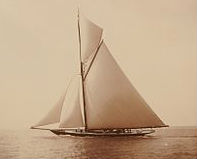 HMY Britannia was the personal sailing yacht of two British kings. Built in 1893 for Albert Edward, Prince of Wales, who later became King Edward VII, the Britannia would also be sailed by his son, King George V. Designed by the Scottish designer, George Lennox Watson, the yacht won 231 races and took another 129 flags over her long racing career. The Britannia followed King George V to his grave. In accordance with his dying wish, on 10 July 1936, the yacht was stripped of her spars and fittings and her hull towed out to St Catherines Deep near the Isle of Wight where she was scuttled. Britannia‘s burgee and racing flag were presented to the Royal Dorset Yacht Club, where they are still on display.
HMY Britannia was the personal sailing yacht of two British kings. Built in 1893 for Albert Edward, Prince of Wales, who later became King Edward VII, the Britannia would also be sailed by his son, King George V. Designed by the Scottish designer, George Lennox Watson, the yacht won 231 races and took another 129 flags over her long racing career. The Britannia followed King George V to his grave. In accordance with his dying wish, on 10 July 1936, the yacht was stripped of her spars and fittings and her hull towed out to St Catherines Deep near the Isle of Wight where she was scuttled. Britannia‘s burgee and racing flag were presented to the Royal Dorset Yacht Club, where they are still on display.
 A sure sign that Spring has finally arrived in New York harbor is the return of the Working Harbor Committee‘s Hidden Harbor Tours. The first, scheduled for May 1st, is Forgotten Harbor, Found in Art. Here is the description of the two-hour tour:
A sure sign that Spring has finally arrived in New York harbor is the return of the Working Harbor Committee‘s Hidden Harbor Tours. The first, scheduled for May 1st, is Forgotten Harbor, Found in Art. Here is the description of the two-hour tour:
Join the Working Harbor Committee on a unique Hidden Harbor® Tour of the history of NYC maritime art in our working waterfronts. The tour will take us to places in the harbor where famous scenes of historical art have been captured in public art you can visit in NYC!
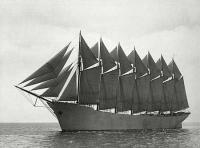 The seven-masted iron schooner Thomas W. Lawson, delivered in 1902, is remembered as the largest schooner ever built and the largest pure sailing vessel, in terms of tonnage, to ever sail. Mostly, however, she is remembered for her rig. She was the only seven-masted schooner in commercial service. She carried primarily coal and oil in her short career. She was lost off the island of Annet, in the Isles of Scilly, in a storm on December 14, 1907, killing all but two of her crew of eighteen and a harbor pilot. Her cargo of 58,000 barrels of light paraffin oil caused one of the first large marine oil spills.
The seven-masted iron schooner Thomas W. Lawson, delivered in 1902, is remembered as the largest schooner ever built and the largest pure sailing vessel, in terms of tonnage, to ever sail. Mostly, however, she is remembered for her rig. She was the only seven-masted schooner in commercial service. She carried primarily coal and oil in her short career. She was lost off the island of Annet, in the Isles of Scilly, in a storm on December 14, 1907, killing all but two of her crew of eighteen and a harbor pilot. Her cargo of 58,000 barrels of light paraffin oil caused one of the first large marine oil spills.
Each of the masts, as well as each of the 27 sails, had to have names. But how does one name seven masts? Looking into it, I found that according to Lars Bruzelius’ The Maritime History Virtual Archives, at least, eleven different naming schemes were used to keep track of the masts. That is right, eleven different sets of names for the seven masts.
Continue reading
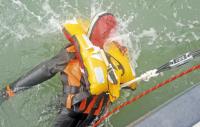
Photo: Bob Aylott
On April 1, Sarah Young was swept from the cockpit of the yacht IchorCoal sailing in the middle of the Pacific Ocean in the Clipper Round the Word Race. By the time the crew reached her, she had died. She was wearing a life-jacket with an AIS locator device but she had not been tethered to the boat. Many have commented that being tethered might have saved her life.
On the other hand, going overboard without being clipped in is not necessarily a death sentence. In the previous Clipper Race in 2014, Andrew Taylor, 46, from London, a crew member on Derry–Londonderry–Doire yacht fell overboard in the Pacific, untethered, and was rescued safely after ninety minutes in the water.
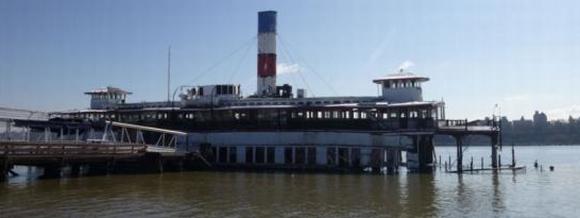
See additional photographs below.
We have been asked to post this public notice seeking interested parties to remove and restore the Ferryboat Binghamton, now aground, flooded and seriously damaged in the Hudson River off Edgewater, NJ. Interested parties should email FerryboatBinghamton@gmail.com for more information.
PUBLIC NOTICE :
FERRYBOAT BINGHAMTON REMOVAL FOR PRESERVATION AND RESTORATION
BOROUGH OF EDGEWATER, NEW JERSEY
The NOEL LOVE GROSS, TRUSTEE OF TRUST B UNDER ARTICLE IIIB OF THE LAST WILL AND TESTAMENT OF NELSON G. GROSS seeking interested qualified parties to enter into an agreement to remove the ferryboat Binghamton from its current site, in Edgewater New Jersey, for the purpose of preservation and restoration.

Sea Hunter Being Made Ready for Sea Trials Photo: DARPA
The US military is testing the technology for Sea Hunter, the first ASW Continuous Trail Unmanned Vessel (ACTUV), a 132 feet long autonomous drone ship designed to track enemy submarines. The ship is designed to be unmanned and operate autonomously and/or by remote control. Each ACTUV is expected to cost around $20 million dollars. The project was initiated by the Pentagon research group, the Defense Advanced Research Projects Agency (DARPA). The Navy could move to the next phase of development by 2018. If the project is successful it could have a major impact on the role of drones in both maritime security and ship operations.
The US Navy is facing the challenge of countering the potential threat from a new generation of diesel-electric submarines. The new submarines are more silent and stealthy than nuclear submarines and far cheaper to build and operate. The concern is that China, Iran or some other nation might be able to send a fleet of these subs toward the United States and overwhelm US anti-submarine tracking capabilities. The idea is to counter this threat by using a fleet of unmanned drone ships to detect and continuously track diesel-electric submarines.
Two hundred and forty years ago today, the Continental Congress authorized the commissioning of privateers to attack British ships. It was still three months before the Declaration of Independence from Great Britain. The legislation was in many respects simply catching up with what was already going on in New England and elsewhere along the coast. A year earlier, in the spring of 1775, the colony of Massachusetts had begun commissioning privateers. Likewise, General Washington began chartering schooners to act as commerce raiders to help supply his army surrounding Boston.
Over the course of the war, about 1,700 Letters of Marque and Reprisal, which is to say, privateering commissions, were granted to nearly 800 privateering vessels, which captured or destroyed about 600 British ships. By comparison, the Continental Navy never numbered more than 70 vessels and captured fewer than 200 British ships.

Sarah Young
Terrible news. A second sailor has died in the Clipper Round the World Race. On 1127 UTC on Friday, Sarah Young, 40, was swept over the side of the IchorCoal boat (CV21) in the Pacific Ocean by a series of waves, after reefing the mainsail. She was not tethered to the boat and was carried off in 35 – 40 knot winds. Her body was recovered but she never regained consciousness. The cause of death is yet to be determined but is suspected to be drowning or exposure. Her death took place at approximately 39 N 160 E, approaching the International Date Line, on the 12th day of the ninth race between Qingdao, China, and Seattle, USA, with over 3,242 miles left to reach its destination.
Last September, four days after the start of the Clipper Round the World Race, Andrew Ashman, 49, a paramedic, suffered a head injury and died while reefing the mainsail, also on the racing yacht IchorCoal (CV21). In the last twenty years of the Clipper Round the World Race, these have been the first fatalities. Thanks to Alaric Bond for contributing to this post.

There is a lot going on in the cruise world these days. There is all the talk about returning the SS United States to service, although probably without a steam plant or much of the original ship coming along for the ride. Then there is the allegedly ongoing project to build a replica of the RMS Titanic, which will be exactly like the original except for more beam, no steam, and no shear, as well as more lifeboats, and, at least, one fewer iceberg. Here, however, is a plan for a ship that would top them all — a ten stack luxury superliner out of Germany.
At this point, it is tempting to start riffing on the German shipowner, Drumpf Line and their “yuge” ship (although the stacks, like ten fingers, do look on the short and stubby side.) The photo above is, in fact, an April Fools photo from Germany in 1938, reprinted by Life magazine. The copy below the photo reads:
“Its launching was announced for April 1. The photographer christened the ship President Roosevelt, declared that among its many superlative features was an auto track on which car-crazy Americans could race just to keep their hands in.”
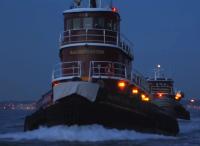 When I arrived in New York back in the mid-70s, a vast fleet of tugs swarmed across the harbor like so many water beetles. Most kept busy assisting ships in docking. Now there are fewer but larger ships, many with bow thrusters, so fewer tugs are needed to get them to their berths.
When I arrived in New York back in the mid-70s, a vast fleet of tugs swarmed across the harbor like so many water beetles. Most kept busy assisting ships in docking. Now there are fewer but larger ships, many with bow thrusters, so fewer tugs are needed to get them to their berths.
Here are two videos about New York harbor tugs, separated in time by more than a half-century. The first “Workhorses of the Harbor!” is about Dalzell Towing in 1954. The second, from the PBS program “New York On the Clock” — “Chris Baker, Tugboat Captain” follows a McAllister tug captain in assisting ships to their berths in 2009. In more than one respect, the two videos are related. Dalzell Towing, which specialized in ship docking, was purchased by McAllister Towing in 1965.


